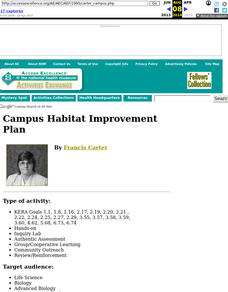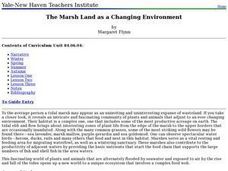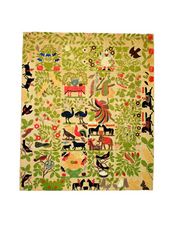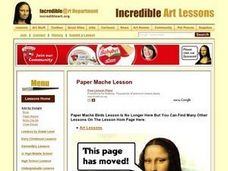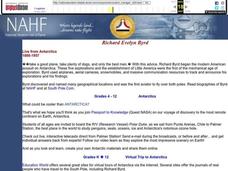Curated OER
What Kind of Animal Are You?
With the descriptions of six different animal groups (amphibians, birds, fish, insects, mammals, reptiles), students match different examples of animals to their proper groups (lizard to reptiles, girl to mammals, etc). The activity...
Curated OER
Using Multicultural Literature with Science
Fourth graders listen to The Great Ball Game and discuss the roots of the tale. In this multicultural tale students identify the realistic facts about the Abnenaki Indians. Students use the Internet to find out about the...
Curated OER
Campus Habitat Improvement Plan
Students work to improve a plot of land. They assess the needs of the environment and formulate a plan. They plant trees and gardens, build bird boxes, construct waterholes. etc.
Curated OER
Louisiana
Third graders study factual information about Louisiana including the state flag, bird, tree, and important geographical points using the Internet and maps. They explain the different groups that settled the state in this mini-unit.
Curated OER
The Skeletal System
Learners identify bones off a skeleton during quizzes; assemble disarticulated skeletons; bird, frog and rat. They dissect frogs, remove the muscle tissue, and identify of bones.
Curated OER
The Marsh Land as a Changing Environment
Sixth graders continue their examination of the state of Connecticut. After taking a field trip, they identify the types of birds, plants, invertebrates and vertebrates who make their home in the salt marshes. In groups, they identify...
Curated OER
Compare Human-made Objects with Natural Objects
Young scholars examine and observe how many human-made objects get their basic design from things in nature. They listen to the book "Nature Got There First," compare/contrast hollow bones with drinking straws, bird beaks and tool...
Curated OER
Wind Power
Fourth graders develop an understanding of how engineers use wind to generate electricity. They will build a model anemometer to better understand and measure wind speed. They discover that engineers design wind turbines that generate...
Curated OER
Animal Classification
Third graders differentiate between vertebrates and invertebrates, and identify the main characteristics of mammals, fish, reptiles, amphibians, and birds. They sort and categorize different types of balls, discuss the characteristics...
Curated OER
Small Pond Creatures
Students complete a unit about the different creatures that can live in a small pond habitat. They create a glossary, create a class Small Pond mural, develop a Frog Fact File, read a variety of books, and conduct research for a report...
Curated OER
My State Symbols
In this social studies worksheet, students investigate information particular to their home state and illustrate it. Students research their state flower, tree, gem, mammal, bird, motto, song and nickname.
Curated OER
Summer Activities: The Wonders of Nature!
Students examine the world of nature. In this early childhood lesson plan, students develop observation skills as they bird-watch and make rainbows, experimentation skills as they explore seeds and carrots, prediction skills as they...
Curated OER
Bernoulli's Principle and Winged Flight
Third graders study Bernoulli's Principle and Winged Flight. In this biology lesson plan, 3rd graders to see how the decrease in air pressure which occurs when air is moving allows birds to fly.
Curated OER
Counting Quilts
Students view the Bird of Paradise quilt and observe the design-work in the quilt. In this counting quilt lesson, students will count to find repeated pictures in the quilt. Students will represent their families in...
Curated OER
I Have No Money, Would You Take Wampum
Students engage in a discussion about their experiences with goods, services, and money. In this bartering lesson, students read The Wampum Bird story and brainstorm their personal experiences with economics.
Curated OER
Kingdom Animalia ~ A Look at the Five Major Classes
Biological taxonomy masters examine the five main classes under phylum chordata. Pupils compare and contrast the identifying characteristics of the various organisms. They explain why taxonomy is important in classifying organisms. You...
Curated OER
Boombox Classroom: Migration of Music
In this music worksheet, pupils draw quarter notes and half notes. The lesson is dependent on classroom access to a musical lesson from Boombox classroom, found at the Sweet Bird Classics home page.
Curated OER
BIRDS OF A FEATHER
Students observe and identify characteristics of artifacts and fossils; explain how artifacts and fossils are used to explore the past; and identify ways that Native Americans prepared food and made tools
Curated OER
Building a Mini-park And Bird Sanctuary Lesson 3: Location, Location, Location
Students work cooperatively using the democratic process to select a place for a park. They identify how the garden in the park will look. They write a five paragraph essay as an assessment.
Curated OER
Paper Mache Birds - Pueblo Pottery Inspired
Students explore the Pueblo culture and art work. Students compare and contrast various forms of artistic expression and discover how artists get ideas. Students use a variety of resources to gain an examineing of artists and art forms....
Curated OER
Richard Evelyn Byrd: Live from Antarctica
Students explore Richard Evelyn Bird and his flights over Antarctica. They conduct an online journey of the Polar Duke to discover where to study penguins, seals, oceans, ice and Antarctica's ozone hole. They create their own Antarctic...
K5 Learning
The Fishhawk
Read about why the osprey is also known as the fishhawk in a short reading passage that describes where they live, what they eat, and what they look like. After reading, individuals respond to four short answer questions based on...
Teachit
Life Cycle of a Penguin
Celebrate the circle of life with this fun hands-on activity. After cutting out, gluing together, and assembling this visual model, students are able to spin through and observe the life cycle of penguins.
K12 Reader
Jabberwocky
Readers demonstrate their ability to use word endings and word relationships to identify the parts of speech of the nonsense words in Lewis Carroll's "Jabberwocky."
Other popular searches
- Common Birds
- Tropical Birds
- Pet Birds
- Aquatic Birds
- Bird Migration
- Bird Beak Adaptation
- Flightless Birds
- Birds of Prey
- Bird Feeders
- Bird Adaptations
- Bird Nests
- Birds in Flight




